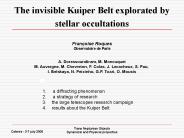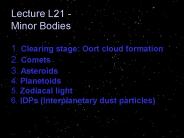Neptunian PowerPoint PPT Presentations
All Time
Recommended
The invisible Kuiper Belt explorated by stellar occultations ... The Fresnel scale. The Fresnel scale is a scaling factor. of ... is 3 (in Fresnel scale! ...
| PowerPoint PPT presentation | free to download
Most large TNOs may have multi-satellite systems, which record their formation ... An NGAO survey of large TNOs would find all satellites 100 km diameter out ...
| PowerPoint PPT presentation | free to download
Trans-Neptunian Objects Recent discoveries of the icy bodies populating the outer solar system by the powerful Hubble Space Telescope and several new ground-based ...
| PowerPoint PPT presentation | free to view
Occultation of X-Rays from Scorpius X-1 by Small Trans-Neptunian Objects (2006, Nature Letters) ... The discovery of X-ray occultation by small TNOs opens up a ...
| PowerPoint PPT presentation | free to view
first landing on a jovian moon. Assorted Neighborhood Ruffians. Pluto - more like a jovian moon. than a planet. Trans-Neptunian objects - recent ...
| PowerPoint PPT presentation | free to view
... and the Trans-Neptunian or Kuiper Belt Objects. Highly elliptical orbit inclined 170 to ecliptic ... Brings it inside Neptune's orbit, 1979 1999, Pluto was ...
| PowerPoint PPT presentation | free to view
Transgender Dating in New York is now easy as it could get with My Transgender Cupid. We are the most trusted online platform that work to connect people who are looking for true trans relationship.
| PowerPoint PPT presentation | free to download
Paula G. Benavidez & Adriano Campo Bagatin ... Ecliptic plane. zone 3. A collisional model for TNOs. Collisional evolution for each zone: ...
| PowerPoint PPT presentation | free to download
Title: The REAL OCCULT: Author: Harold Williams Last modified by: Montgomery College Created Date: 11/8/2003 6:41:19 PM Document presentation format
| PowerPoint PPT presentation | free to download
13.15 Other Objects in our Solar System The Moon the moon orbits Earth every 27.3 days the moon rotates once on its axis as it completes one orbit around Earth as a ...
| PowerPoint PPT presentation | free to view
... Mars: ~5 gm/cm3 Jupiter, Saturn, Uranus, Neptune: ~1 gm/cm3 Reference ... Christine Lavin References Much more information on Pluto is ...
| PowerPoint PPT presentation | free to download
Moons, Rings, and Pluto. Pluto. Saturn's Rings. Shepherd Moons. Jupiter's Ring ... Moon's of Jupiter. Io. Europa. Ganymede. Callisto. Metis, Adrastea, Amalthea, ...
| PowerPoint PPT presentation | free to view
Pluto Scientists calculated that Neptune s gravity was not ...
| PowerPoint PPT presentation | free to view
Kuiper belt objects: planet candidates in the Solar System. New definitions: planet (8), dwarf planet (3), small solar system bodies ...
| PowerPoint PPT presentation | free to view
our Milky Way. galaxies. Big Bang. history/future of the Universe. dark matter/energy ... many moons. jovians. gas giants. Jupiter, Saturn. ice giants. Uranus, ...
| PowerPoint PPT presentation | free to download
Title: What happened to Pluto? Author: jcarlo Last modified by: Jeremy Carlo Created Date: 9/7/2006 4:51:24 PM Document presentation format: On-screen Show (4:3)
| PowerPoint PPT presentation | free to download
... Pluto ... Features of Pluto. The other bright regions may be areas where impacts have ... Pluto's moon Charon was discovered as a small bulge in a high ...
| PowerPoint PPT presentation | free to view
Ceres has diameter of about 30% of that of the Moon. Earth. Ceres ... Moon. Asteroid. Gaspra from the. Galileo spacecraft which passed within 1600 km ...
| PowerPoint PPT presentation | free to download
4 Terrestrial Planets Mercury Venus Earth Mars 4 Jovian Planets Uranus Neptune Jupiter Saturn (gas giants) (ice giants) Differences in the 2 Main ...
| PowerPoint PPT presentation | free to view
Archbishop James Ussher concluded in 1658 that the world was completed by God on ... Two lines of changes can be traced in the Earth's crust: changes in inorganic ...
| PowerPoint PPT presentation | free to download
With the advent of powerful new telescopes on the ground and in space, recent new discoveries have been made of objects in the outer regions of our Solar System that ...
| PowerPoint PPT presentation | free to view
THE BUSHVELD COMPLEX: DYNAMIC PROCESSES AT ALL SCALES ... Chromium Great Dyke, Bushveld Antimony Murchison. Gold Witwatersrand Copper Various, e.g. O'Kiep, ...
| PowerPoint PPT presentation | free to view
Numerous small, icy bodies beyond Neptune's orbit similar to Pluto and Charon in ... Eris. New Designation -- Dwarf Planet. Spherical, orbit not cleared of ...
| PowerPoint PPT presentation | free to view
Take up worksheets-other objects in solar system-solar system chart Measuring distance from Space Why do we need special units for astronomy -we are dealing with a ...
| PowerPoint PPT presentation | free to view
Giants of Geology Giants of Geology Nicola Steno 1638 - 1686 Steno s Laws Nicola Steno Fossils Robert Hooke (1635-1703) Robert Hooke (1635-1703) Robert ...
| PowerPoint PPT presentation | free to download
The New (old) Planets So what do we do with Pluto? It is now classified as a Dwarf Planet along with Eris and Ceres (the asteroid). What is a Dwarf Planet?
| PowerPoint PPT presentation | free to download
Title: PowerPoint Presentation Last modified by: Jie Zhang Created Date: 1/1/1601 12:00:00 AM Document presentation format: On-screen Show Other titles
| PowerPoint PPT presentation | free to download
Moons The satellites of the solar system
| PowerPoint PPT presentation | free to download
Superposition - The scientific law stating that in any unaltered sequence of ... Developed the general geologic history of the Urals ...
| PowerPoint PPT presentation | free to download
With the advent of powerful new telescopes on the ground and in ... Credit: Lynette Cook and W. M. Keck Observatory. Credit: NASA. How Many. Planets... In Our ...
| PowerPoint PPT presentation | free to view
Giants of Geology Nicola Steno 1638 - 1686 Steno s Laws Nicola Steno Fossils Robert Hooke (1635-1703) Robert Hooke (1635-1703) Robert Hooke (1635-1703 ...
| PowerPoint PPT presentation | free to download
11.2 The Sun and the Planets See pages 382 - 383 Our Sun, an average star in the universe, is the center of our solar system. Our solar system is full of planets ...
| PowerPoint PPT presentation | free to download
Discovered in 1992 by David Jewitt & Jane Luu. Estimated 70,000 objects 100km ... Thick: up to 10 outside ecliptic. More diffuse distribution extends further ...
| PowerPoint PPT presentation | free to view
The Solar System The solar system is the sun and everything that revolves around the sun.
| PowerPoint PPT presentation | free to view
Amazing facts: At 10 cm wavelength, 1 free electron will cancel the refractive ... (6) EQUARS. C/NOFS. NPOESS (3) METOP. ACE (4) TerraSAR-X ? Coming Attractions...
| PowerPoint PPT presentation | free to view
The following presentation has been formatted to not fit your screen Triton: The World that should not be. Adric Riedel Things that are wrong with Triton Wasn t ...
| PowerPoint PPT presentation | free to download
Juno 1804 (asteroid) Vesta 1807 (asteroid) Neptune discovered in 1846. Now are there 12 planets? ... Juno. Vesta. et al. Now we have reduced the number of ...
| PowerPoint PPT presentation | free to view
(1) Center for Studies and Activities for Space, University of Padova ... Phoebe hole. Primordial orbits. Green dots: computed pre-capture orbits ...
| PowerPoint PPT presentation | free to download
(1) Ceres, (2) Pallas, (3) Juno, (4) Vesta. Minor planet numbers: ... Damocles (q=1.58 AU; Q=22 AU; i=62 ) 30 in Jupiter Family orbits ...
| PowerPoint PPT presentation | free to view
Title: Light: The Cosmic Messenger Author: Megan Donahue Last modified by: Harold Williams Created Date: 2/2/2004 6:54:02 PM Document presentation format
| PowerPoint PPT presentation | free to download
Pluto is so named because it is at the grim, scary edge of the solar system. Pluto was discovered at Lowell Observatory and its first 2 letters commemorate ...
| PowerPoint PPT presentation | free to view
Title: Pr sentation PowerPoint Last modified by: Alain Doressoundiram Document presentation format: Personnalis Other titles: Gill Sans ProN W3 ...
| PowerPoint PPT presentation | free to download
is scattered by a large one, nearly missing it and thus gaining an ... from the Keck Observatory Laser Guide Star Adaptive Optics system. Satellites are seen ...
| PowerPoint PPT presentation | free to download
Pluto was discovered in 1930 by Clyde Tombaugh and was given the title of the ninth planet. Pluto has three moons, the largest of which is Charon. ...
| PowerPoint PPT presentation | free to view
Asteroid Ceres was discovered between the orbits of Mars and Jupiter in 1801. ... are: Mercury, Venus, Earth, Mars, Jupiter, Saturn, Uranus, and Neptune. ...
| PowerPoint PPT presentation | free to view
(trough the European Southern Observatory). It will consist of an array ... At distances of 40-50 AU, KBOs have temperatures near 45 K, ...
| PowerPoint PPT presentation | free to view
... IAU therefore resolves that planets and other bodies, except satellites, in our ... (1) A planet is a celestial body that (a) is in orbit around the Sun, ...
| PowerPoint PPT presentation | free to view
Formation & Evolution of Planets. Sun / Dynamo-driven ... schools in the Ruhr Valley as well as in Lower Saxony. Summer 2002. The Basic Idea of the Project ...
| PowerPoint PPT presentation | free to view
Oceans in the Outer Solar System
| PowerPoint PPT presentation | free to view
Smaller Bodies in the Solar System By Kynsey Creel http://www.agdesktop.com/wallpapers\space\stars\star-0005.jpg Topics Asteriod Belt Pictures History of Discovery ...
| PowerPoint PPT presentation | free to view
... properties of the TNOs in the framework of the current planet config. ... planets; Grey: ... planet is in a 1:1 secular resonance with the small body, so ...
| PowerPoint PPT presentation | free to view
Pushing the limits on what a backyard observer can do with modest amateur equipment ... WAT 902H2 Ultimate or Supercircuits PC164C security video camera ...
| PowerPoint PPT presentation | free to view
Moons Cordelia and Ophelia act to shepherd some rings. Ring Discovery from Occultation ... 1st observed by Galle (German) on 9/23/1846. Neptune. Scale of ...
| PowerPoint PPT presentation | free to download
The largest known dwarf planet. Has one moon, Dysnomia. Eris * The Sun ... Meteoroid Largest body in the asteroid belt and only known dwarf planet in this region.
| PowerPoint PPT presentation | free to view
... Will be Out of This World!!! By Seanie Civale. Kayla Anderson ... Neptune was named for the Roman god of the sea. It's symbol is his fishing spear, or trident. ...
| PowerPoint PPT presentation | free to view
























































